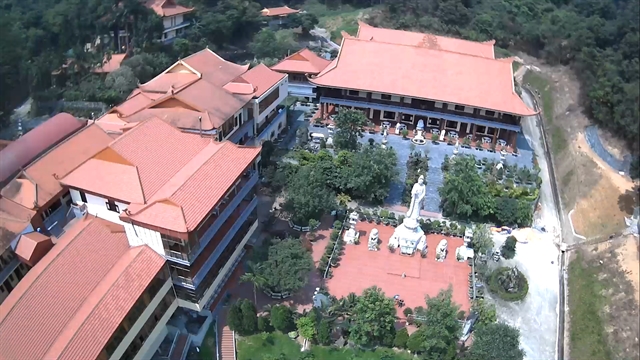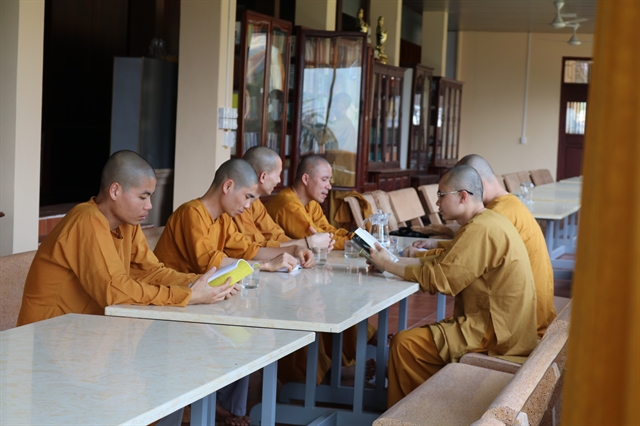
Place of peace: Trúc Lâm Yên Tử Zen Monastery in Quảng Ninh Province is among more than 100 monasteries of Trúc Lâm Zen sect in Việt Nam. VNS Photo Hồng Minh
By Minh Vân Hoa
QUẢNG NINH Monk Thích Trúc Tử Hoàng used to live a pretty normal life. He was born in the late 1980s and studied for a degree in engineering before spending some years working for a construction company.
Everything was supposed to go as planned – earning money, buying a house, getting married and having children like many other young Vietnamese people. Tử Hoàng said he used to cling onto material goods and would never believe in things that science cannot explain.
But he gradually felt something was not right.
“When I was a third-year student, I suddenly felt lost,” he said, “I did not know what I was living for and what the purpose of my life was.”
After reading a book about Buddhism, he found his calling and decided to become a Buddhist monk at the age of 26. He chose a Buddhist sanctuary on Yên Tử, a high mountain range lying in the northern province of Quảng Ninh, as the place to find all of life’s answers.
“It can be seen as predestination for my decision, but in another way, I understood that I wanted to follow the Buddhist teachings of letting go of my ego and selfishness to devote myself for others’ benefit,” Tử Hoàng said.
After six years practising Zen at Trúc Lâm Yên Tử Monastery, Tử Hoàng said he had been enlightened and had found that the teachings of the Trúc Lâm Zen sect really matched what he wanted to know.
“It must be the reason Buddhist King Trần Nhân Tông (the founder of the Trúc Lâm Zen sect) gave up everything when he was at the height of power as a king to lead an ascetic religious life and I want to learn about it,” he said.
Buddhism of Vietnamese
Now Tử Hoàng and 100 others are regular monks at Trúc Lâm Yên Tử Monastery. Every day they practise Zen, learn about Buddhism and live their monks’ life.
Every Sunday, some 1,000 Buddhist followers also visit the monastery to practise Zen. During summer vacation, students and lecturers come to learn or research about Buddhism.

Quiet time: Monks read Buddhism books at Trúc Lâm Yên Tử Zen Monastery's library. There are 100 monks studying and practising Zen at the monastery. VNS Photo Hồng Vân
The Most Venerable Thích Tuệ Phúc, Deputy Manager of the Trúc Lâm Yên Tử Monastery, said that more and more people come to the monastery as they want to experience the unique Buddhist culture of the Vietnamese people created by founder Buddhist King Trần Nhân Tông (1258-1308).
According to Thích Tuệ Phúc, Buddhism first came to Việt Nam more than 2,000 years ago. Throughout the Lý (1010-1225) and Trần (1225-1400) dynasties, which spanned some 400 years, Buddhism was the national religion in Việt Nam.
“But Buddhism in Việt Nam at the early time was mostly influenced by that of India, China and Champa and we did not have any Buddhist sect of our own,” said The Most Venerable Thích Tuệ Phúc.
He said it wasn’t until the 14th century that Việt Nam had its own Buddhist culture after the third king of the Trần Dynasty, King Trần Nhân Tông, passed the throne to his son, then King Trần Anh Tông, and advised him for six years, then he came to Yên Tử to become a Buddhist monk in 1299 at the age of 41, and later found a Vietnamese Buddhist sect.
“After King Trần Nhân Tông achieved Buddhahood, he founded a Buddhist sect called Trúc Lâm (Bamboo Forest) Zen - the one Buddhist Zen sect for the Vietnamese people,” he said.
The most venerable monk explained that as Trần Nhân Tông was born a king and also led the country to victory over the powerful Mongolian army of the Yuan Monarchy in two wars in 1285 and 1287, so he appreciated and treasured the country’s culture.
“The king wanted all descendants to respect the country’s cultural nature because with the love of the country, each person would help contribute to the national cause,” he said.
“As Buddhism is a spiritual path of wisdom, the king wanted people to learn Buddhism from very early in life, and in this case the Buddhist religion belongs to our country Đại Việt, because it is true to the aspiration and the sentiment of Vietnamese people,” he added.
According to The Most Venerable Thích Tuệ Phúc, the Trúc Lâm Zen sect founded by Buddhist King Trần Nhân Tông served the cause of consolidating the national power to build and defend the country. All Three Patriarchs of Trúc Lâm Zen sect, including Buddhist King Trần Nhân Tông and his two successors – Master Pháp Loa and Master Huyền Quang, advocated incarnation, building and developing the country with the compassion, wisdom and morality of Buddhism, he said.
“They all took national interests and sentient beings as a fundamental goal in the process of learning and practising Buddhism by each individual,” he said.

: A monk at Trúc Lâm Yên Tử Zen Monastery cuts an old tire for rubber binding strings as a way of recycling. VNS Photo Hồng Vân
According to the doctrine of Trúc Lâm Zen sect, keeping the mind pure is a prerequisite for enlightenment.
“Trúc Lâm Zen sect is a monastic discipline which means those who want to follow must let go of all attachments so that they have more time to meditate, to enlighten themselves,” said The Most Venerable Thích Tuệ Phúc, adding a Zen monastery saying that “Let go of all and we will have all.”
“Because when we are brave enough to let go of everything, we become enlightened and we are no longer bothered by benefits, fame and external things,” he added.
According to Thích Tuệ Phúc, now there are more than 100 monasteries of Trúc Lâm Zen sect in Việt Nam. There are also monasteries in the US, France and Australia.
Nguyễn Thị Thu Hà, a Buddhist follower who lives on Hà Nội’s Thanh Nhàn Street and has been attending Trúc Lâm Yên Tử Zen Monastery’s Zen classes for more than seven years, said she found the Zen sect very close to daily life.
“I see that the Trúc Lâm Zen sect has simplified the practice without being attached to the ritual. It does not distinguish between monks and nuns at the temple so it’s quite easy for me to practise,” she said.
Hà explained that both forms of practice were aimed at the common goal of finding and awakening the good nature in the mind of each individual in the path of compassion and wisdom.
“It is a Zen sect of Buddhism with a national culture and a cultural element of true Việt Nam,” she said.
Young monk Thích Trúc Tử Hoàng said he felt happy being able to help other people enlighten themselves.
“Whenever some young people come to the monastery when they face impasse in life and find the answer in Zen and Buddhism here, I feel so happy,” he said.
“Because serving the Dharma is to direct the mind to help other people,” he added. VNS
OVietnam